The Next Generation of Shipping Tech is Now
Dig into Shipium's features to see what's possible with the most modern shipping management system available
Platform
Bridge your existing frontend systems with backend operations with a platform that reduces costs, empowers a competitive customer experience, and wrangles operational complexity. The power is in the platform.
Enterprise-Grade Cloud Infrastructure
Shipium is purpose-built to meet the most demanding enterprise needs.
Ridiculously Good Performance
The platform powers the shipping operations of some of the largest industry leaders, including dozens of global retailers and 3PLs processing millions of shipments per month.
The platform had zero unplanned downtime in 2022 across customer-facing services because of its elastic architecture, ensuring uptime standards that meet intense customer demands.
Integration
As a cloud platform, integratng products with your systems is fast and reliable.
Rely on enterprise-grade SLAs on system performance and uptime. This is priority number one for the platform because most of what Shipium does is mission critical to our customers' operations.
Security, Privacy, and Compliance
Strict privacy guidelines ensures no proprietary data is inappropriately shared. Shipium's compliance program strives to meet the most important certification requirements for enterprise customers.
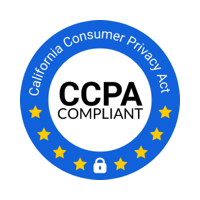
All shipping data is anonymized and meets the standards to be qualified as non-PII. Customer data is never shared with other customers.
Account Management
Setting up and managing users, customers, and accounts has never been this easy. Account management tools give powerful and flexible capabilities whether as a single entity (like a retailer), or a business servicing many customers (like a 3PL).
User Setup
Shipium provides thorough user set up with access permissions that includes pertinent information such as fulfillment network configuration, enabling API access and testing, and proper user training.
Customers can add/manage console users (User, Editor, Administrator) based on roles and permissions, and can also reset passwords as needed.
Multi-Party Management
The platform is designed to support a multi-tenant architecture, supporting businesses like 3PLs, marketplaces, and dropship vendors.
3PLs can set up accounts for their customers (tenants) within an easy-to-use console, which can inform and scope almost all Shipium features to that specific customer. For example, 3PLs can make available only certain carriers to certain customers.
It's easy for 3PLs to resell their own accounts for carriers. They simply set up their accounts, then use powerful and flexible features to determine things like margin and assignment. Just like with everything else, the new offering can be cuzstomized and propogated across their customers (tenants), origins, carriers, and service methods.
Bill another account (a 3rd party) for shipping cost, which typically includes a surcharge or additional cost. Shipium's console can store 3rd party information including account number, billing city and postal code.
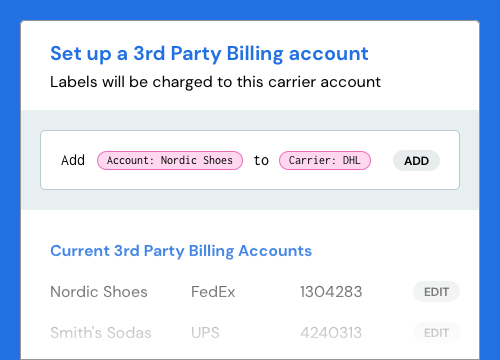
Pre-Integrated Carrier Network
Shipium has assembled the best network of carriers available to parcel shippers. It's the network carriers wish you used because of the speed of setting up new carriers, the ease of managing and maintaining them, and the stability of carrier performance and availability.
Supported Carriers
The network offers a robust list of in-network national, regional, and international carriers to its customers. Turning a new carrier on is an afternoon activity, with no integration fee. Any carrier not on the Shipium network can be added in 8 weeks or less at no cost.
Domestic Carriers
Over 98.7% of all domestic shipments are covered by carriers immediately available on Shipium's network.
Assured coast-to-coast coverage with support for the four major national carriers UPS, FedEx, DHL, and USPS. Our network is pre-integrated to all major service methods across carriers. When changes pop up among our carrier partners, we are the leading tech solution they turn to, which is a benefit to customers. For example, when USPS launched their new Direct Connect service, Shipium was the first platform to integrate.
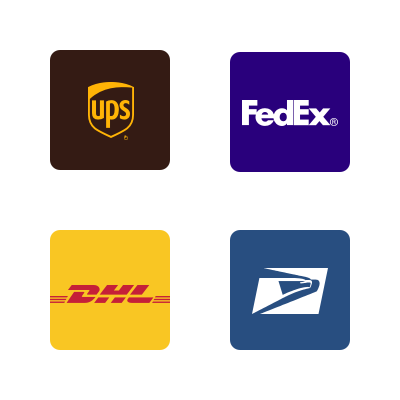
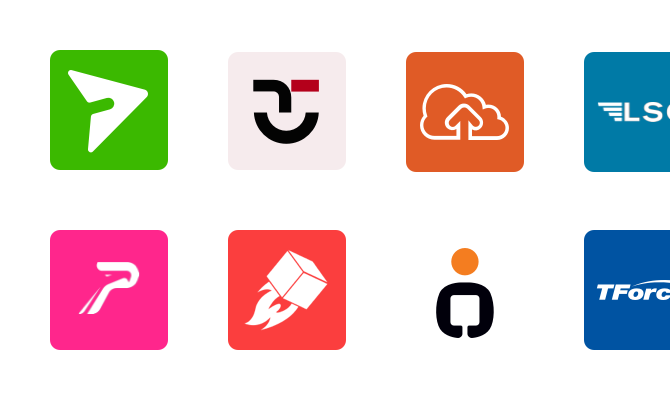
International Carriers
The network has a growing list of international shipping capabilities. Access to all international carriers is the same as domestic carriers: integration with a WMS or OMS is complete, customers can print labels or get tracking information from both domestic and international carriers the same way.
Deliver within Canada with Canada Post and other national and regional carriers through our network. Contact the team for the most recent support.
In-House TransOps Team
Shipium provides an In-house Transportation Ops team that provides services to all customers, such as being technical liaisons with carriers, monitoring and applying macro conditions to network properties, ensuring correct negotiated rates and surcharges are applied, and providing regular support and services to customers.
Routine Upkeep
The daily, weekly, and monthly drudgering of maintaining and updating carrier information, like surcharges, is offloaded to our team. Free up your team's time by relying on our team's expertise.
Offload the management of the fuel, destination, package, value-add, accessorial, and peak surcharge rates of all pre-integrated carriers in our network. Customers can count on us to make sure all values are current for every carrier, then customers can modify their discounts according to their contracts in their unique Shipium account.
Carrier Liaison
The in-house TransOps team acts as a carrier liaison service for challenges that arise. Customers love this because any time an issue with a carrier pops up, like if their API goes down or returned labels are incorrect, Shipium resolves the issue on the customer's behalf.
The team monitors carrier performance, such as their API availability and speed, and resolves issues with carriers when problems arrise on the carrier side.
Carrier Selection
Optimize and execute shipping decisions at warehouses, stores, or anywhere else. Carrier Selection provides an enterprise suite of shipping management tools on top of the industry's best carrier network.
Shipping Operations
Flexibility and responsiveness is key. Easily manage your shipping operations and make changes that quickly update your network without expensive and slow customization or development work. Carrier Selection is the modern shipping management system that enterprise operators love to use because its rich set of features and customization capabilities.
Carriers & Contracts
Set up and manage carriers with a modern console that doesn't look like Windows 95. It's an afternoon activity to turn on or off a pre-integrated carrier in the network.
Set up carriers with a full suite of configuration options, including access to manage service methods, rate tables, surcharge modifiers, fulfillment centers mapping, label configurations and augmentations, and package configurations.

Upload your carrier contracts to make it quick and easy to manage selection. All carrier contract structures are different, so when Shipium adds a carrier to the network, the platform also models out the carrier's contract structure. That makes it simple to upload your rates and surcharges. This eilminates the need for pass-through systems, like label printing API platforms, who simply use your carrier credentials to request rates or print labels.
Ensure fully loaded costs are used during selection by leaning on our surcharge management capabilities. Shipium staffs an in-house transportation ops team who keeps all carrier surcharges up to date, such as fuel surcharges which can update daily. Then, as a part of contract setup, you declare your ammendments to the surcharge cost structure. The result is a fully loaded rate comparison ensuring the cheapest options are always picked.
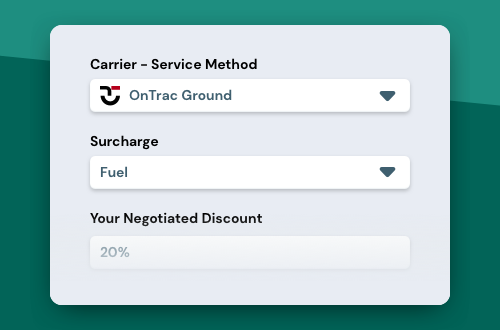
Carrier surcharges are extra costs that carriers assess for shipping packages, typically to cover fluctuating operational expenses. Peak season surcharges, also known as demand surcharges, are temporarily added by carriers to their base shipping rates during periods of high shipping demand. Shipium provides support for different peak surcharges across all carriers which flow into decision making throughout the platform, and manages them for you.
- Use your TNTs
- Use Shipium's TNTs
- Use the carrier's TNTs
Fulfillment Network
Configure all properties of your fulfillment network, such as origin fulfillment days, carrier pickup times, and more. An understanding of your network across warehouses and stores is important to calculating the correct carrier option because of the variability of fulfillment processes.
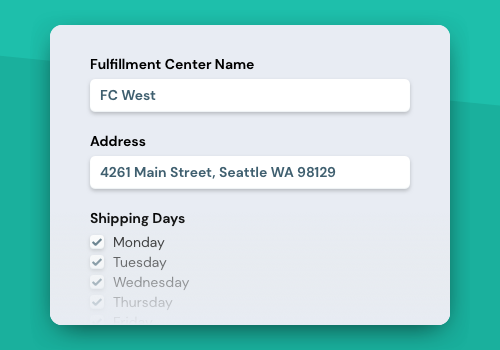
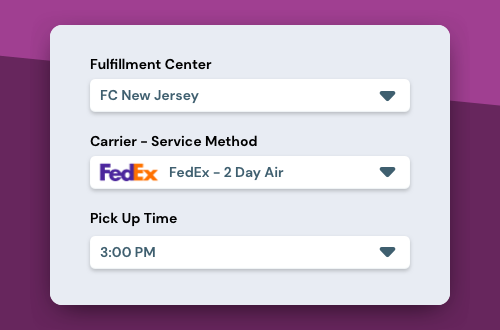
Advanced Features
Your supply chain is unique, so you need a technology partner who can support whatever variations are required for your operations.
Set up inclusion or exclusion rules that take priority during the typical selection process. Customers can ensure their unique use cases are met or scoped before automation occurs.
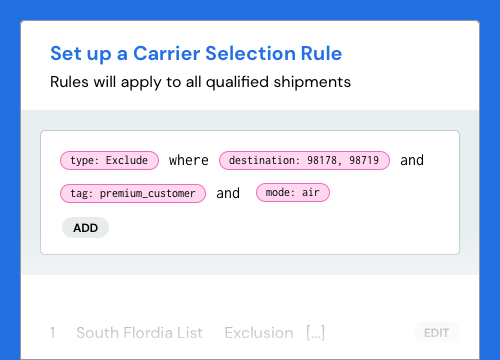

A simple self-service tool lets you set minimum and maximum thresholds per carrier, per service method, per-origin, or per unique property that matters to your operations. Those limits propagate across all Shipium instances once set up.

Shipium partners with carriers to provide safe and proper shipping of hazardous materials. Material types include Limited Quantities (LQ - replaced OMR-D), Lithium Ion Products, and general IATA/DOT materials, and more.
- Category types like lithion ion batteries
- Class types like flammable or poisonous
- Container types like aluminum or wood
- Quantity management
- Warehouses
- Distribution Centers
- Stores
- Dropship
Define you own groups of carrier service methods and rules per delivery zone with our powerful Configurable Ship Option feature. Rules included are carriers and methods, priority level, postal codes, destination matching, package matching, and tag matching.

Hundredweight is a unique consolidation method that some parcel carriers offer, which Shipium supports.
Use bulk API requests within Carrier Selection for rate shopping or label generation. Choose between multiple shipments and one destination, multiple shipments and multiple destinations, and multiple shipments and multiple destinations for rate selection without label creation. The API also allows you to void or cancel calls, too.
Denote BPM shipments with the carrier service methods that support it through both the console and API parameters.
Packaging
Configure packaging options that can be updated at any time.
Set up different packaging types, like boxes versus softpack bags, which can be used a preference during selection, and can impact optimization of carrier selection decisions.
- Boxes
- Poly Bags
- Tubes
Utilize a cartonization API to determine the appropriate set of packaging types and sizes needed for shipping one or more items.
International Shipping
Shipium provides a set of international shipping management capabilities on top of the industry's best international carrier network.
- Passport
- UPS Worldwide
- FedEx International
- DHL International
Handle fully landed duty and taxes for international shipping using carriers who are full-service international carriers on the platform, like Passport, or partner with a D&T technology partner, like Zonos.
Selection Process
Shipium provides the most sophisticated selection process out there, combining automation based on data science with enterprise configurability for maximum customization.
Eligibility Check
Since the carrier network is a centralized cloud platform, Shipium only have to integrates into a carrier once. As part of that integration, the team models out contracts while also declaring properties of the service method. The result is a product like Carrier Selection taking on most business rules for you, eliminating a big chunk of your day to day headaches managing rate shopping.
- Mode
- Hazmat
- Air vs Ground
- Perishable
- P.O. Box
- APO
- Accessorials
Desired Delivery Date
Optionally pass in a date constraint during the selection process. Legacy systems check based simply on carrier SLA times per service method, but Shipium uses a dynamic and sophisticated stochastic data model to understand what will actually happen, thus opening up cheaper shipping options to still hit a desired delivery date.

- Time of Day
- Day of Week
- Day of Year
- Holidays and Seasonality
- Destination Type
- Macro Conditions
- Eligible Carriers
- Packaging
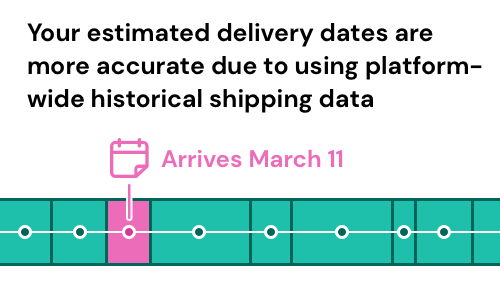
Rate Shopping
Always pick the cheapest shipping option amongst those that are eligible and can hit a date constraint.
Rate shop with fully loaded costs. Legacy rate shopping systems struggle to keep up with rate card continuity as carriers quickly shift rates every week. Meanwhile, companies who built their own rate shopping technology on top of carrier APIs often make a decision based on partial costs because most carriers do not return surcharges via their APIs, resulting in back charges a month later. All that is eliminated with Shipium and guaranteed fully loaded costs while rate shopping.
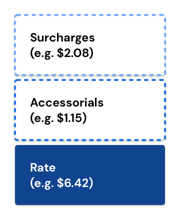
Stable Labels
Modern label technology provides fast, easy to use, and reliable printing a dependable part of your operations.
Label Management
Utilize rich configuration tools to customize labels based on your unique needs.
Customize ZPL to change the layout, data schema, or design of your labels. Use a self-service tool to do it yourself, or ask our team to help.
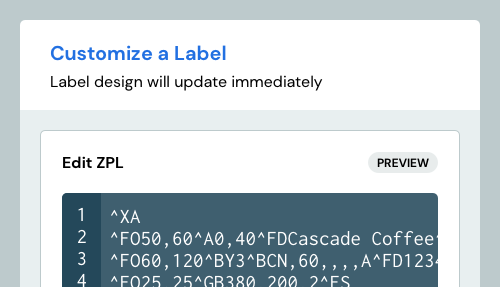
Change the size and orientation of labels, including modifying DPI resolution, with an easy to use interface.
- Required Signature
- Saturday Delivery
- Transportation Type
- Customs
Notify carriers of perishable items in a shipment. All carriers appreciate being notified of a perishable shipment, while some carriers require it. It's easy to set up perishable attribution on labels.
Easily set up special label properties for certain carrier service methods, like bounded matter, delivery signature requirement, weekend delivery statusing, and denoting different shipping types, amongst others.
Maintain rapid label printing to support enterprise-grade throughput with fallback options should a carrier's label printing API underperform a certain threshold. The next cheapest option is immediately available if the best option does not hit a response time limit.
Generate shipping labels without having to provide costing information like carrier service method rates. This feature might be useful for your organization if you wish to print labels without Shipium calculating a shipment cost, and the carrier will bill you once your package has shipped. Using Labels without Costing also could be beneficial if your organization employs tenants in your network and they have their own confidential carrier service method rates; the carrier will bill your tenant once the package ships based on their established rate.
Manifesting
The hassle of manifests are made easy through automation and simple tools you are going to love to use.
Notify carriers of ready-to-go shipments as they happen with automated manifesting capabilities.
Reporting & Analytics
Understand your shipping performance with delivery reporting and analytics package.
Network Performance
Evaluate the performance of your carriers and origins across your network.
Get a detailed breakdown of what carriers are getting volume. Dive in and analyze how those carriers are performing related to package dimweights and geographical zones.

Metrics
Modern operators need modern metrics.
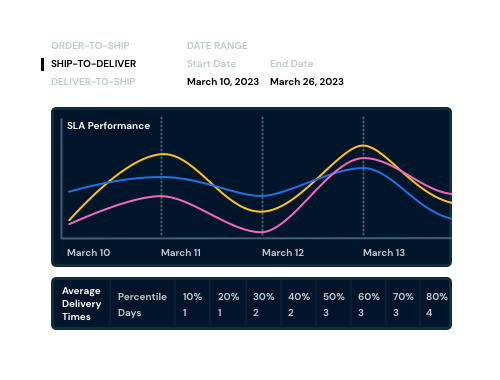
Get an order-to-deliver (OTD, or sometimes call Click-to-Deliver or CTD) composite metric that combines OTS and STD to give you a total view into ecommerce fulfillment performance.
Exports
Download the data you need to accomplish other mission-critical tasks.
Get granular report insights through reconfigurable parameters that include date ranges, multiple aggregate values and which origin to include. Each can provide the selected visual whether line graph, chart or another visual. Most important, it will provide historical performance metrics to allow for continual analysis and enhancements.
Post-Order Operations
Improve internal operations related to active shipments.
Delivery Promise
Increase revenue with reliably fast shipping by providing a pre-purchase delivery date that is competitive and reliable.
Estimated Delivery Dates
Make a promise you can keep with estimated delivery dates (EDDs) powered by the industry's best predictive modeling. These delivery promises create a competitive shipping experience during the buying process which can impact conversion rates 6% on average.
Powered by Data Science
Increase accuracy of EDDs with an extremely sophisticated data model tailored for predictive estimations.


EDDs are ultimately a probabilistic value, coming as close to 100% accuracy as possible, knowing that total accuracy is impossible. The eventual EDD is a statistical composite that predicts the date that is most probable to share with the customer.
Configurability
Shape Shipium's EDDs to fit the unique needs of your business through several advanced configuration possibilities.
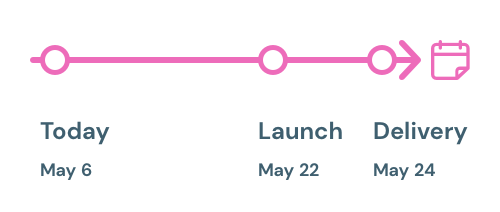
Configure time-in-transit (TNT) models from three available options, including bringing your own, that can be applied to some or all of your inventory.
- Shipium TNTs based on our model (default)
- Your TNT values
- Carrier provided TNT values based on SLAs
Flexible Implementation
Fit Shipium's EDDs into your customer-facing website exactly as you see fit. EDDs are returned via a simple API, making it easy to configure and fit into your design and user experience. Customers love that they can control the experience while getting accurate dates, versus being forced to use a monolithic widget or app.
Data Sourcing
Multiple options to ingest your data makes it easy to fit Delivery Promise to your operations.
For customers who use Carrier Selection, historical shipping data is automatically captured and fed into their Delivery Promise model.
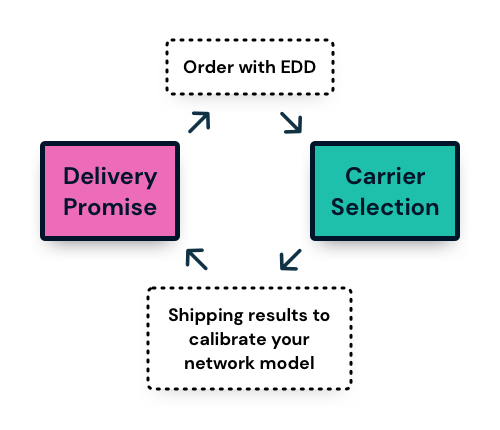
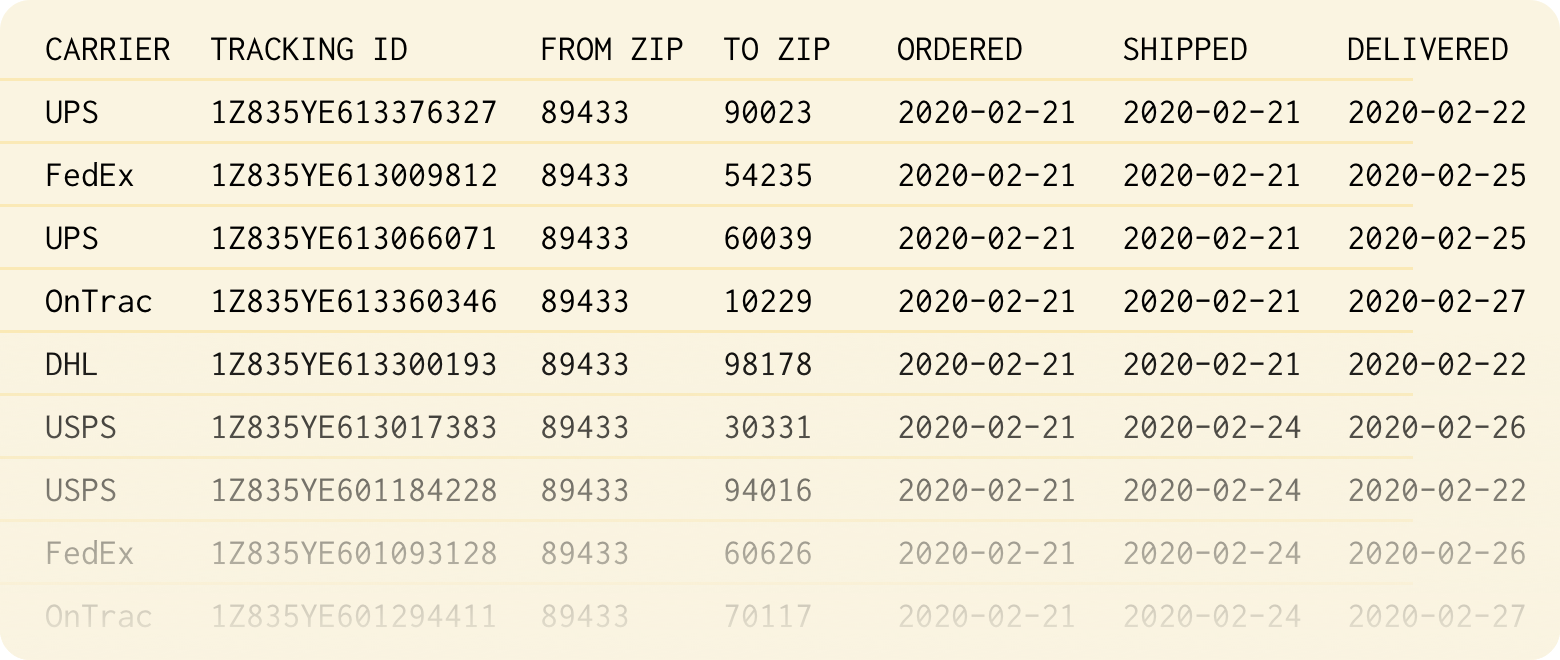
Advanced Capabilities
It's easy to handle different situations unique to your business. Here are a few examples.
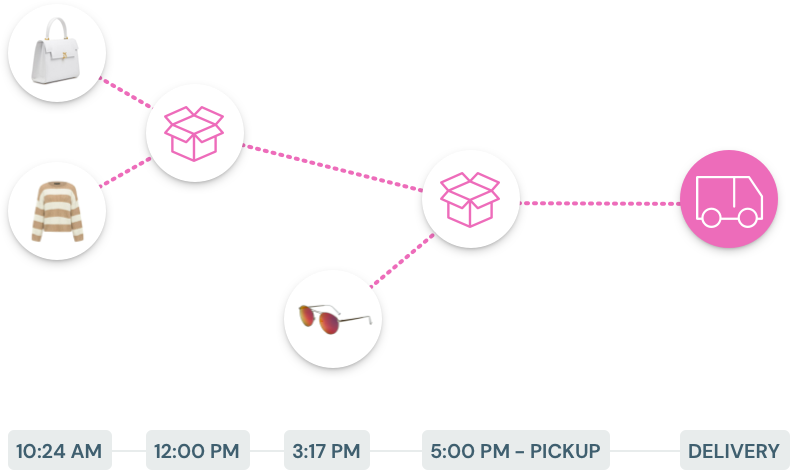
Deployment
Since Delivery Promise EDDs are simply an API call with a rich set of configurability options, it's easy to fit them into multiple pre-purchase experiences during the buying journey.
Show EDDs for a single product on its description page. If the product has variable SKUs, such as different sizes of apparel, utilize the API nature of Delivery Promise to update EDDs on the fly based on possible origin changes based on inventory availability.

Measure how delivery promises improve conversion by using metadata tagging during checkout along a multi-stage workflow. Combined with the flexibility of showing one date or split dates for a multi-SKU order, the ability to tie promises to abandonment and conversion insight is simple and powerful.


Want to see how Shipium works?
Schedule a demo. Our team is happy to answer any questions or provide you an example of our capabilities.